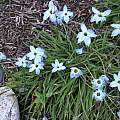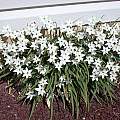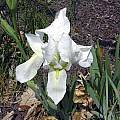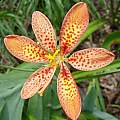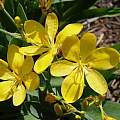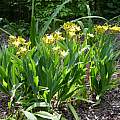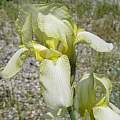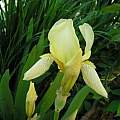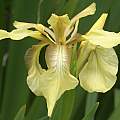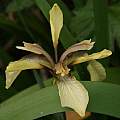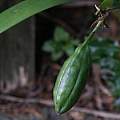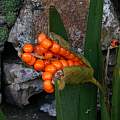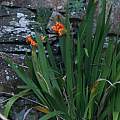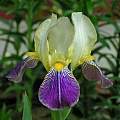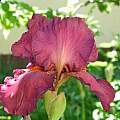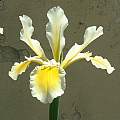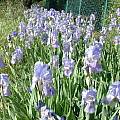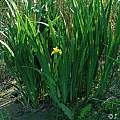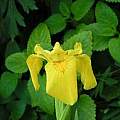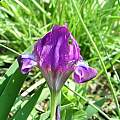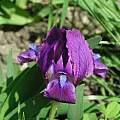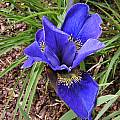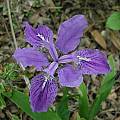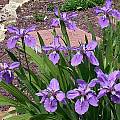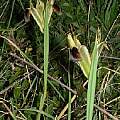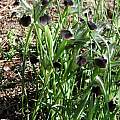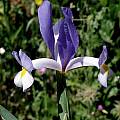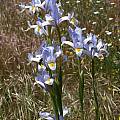On the legacy bulb wiki pages Kathleen Sayce reviews bulbs that outlast their gardeners, with some hints as to why. Suggestions came from PBS list members, review of world weed lists, USDA PLANTS National Database, Flora of North America, and some university databases. For more information consult Legacy Bulbs Index and Introduction.
Information about relevant Ipheion through Iris species can be found on this wiki page. Information about other species is found on the pages linked below:
Albuca through Amaryllis - Anemone through Chionodoxa - Colchicum through Erythronium - Ficaria through Hyacinthus - Ixia through Lycoris - Merendera through Nerine - Ornithogalum through Sternbergia - Trillium through Zephyranthes
Ipheion uniflorum, syn. Tristagma uniflorum, spring starflower, persists and can be invasive in mild climates. Native to Argentina and Uruguay, this geophyte grows in WHZ 6-10. It thrives in sunny well-drained situations; it is winter-growing, spring-flowering and summer-dormant. States where this species has naturalized or established include Oregon, California, Texas, and southeastern states to Virginia.
When I undertook to collect information on introduced geophytes that survive and persist long after their gardeners, and gardens, are gone, I did not expect to find more than ten iris in this category. Yet there are almost twenty species and varieties that clearly outlast their gardeners. One is a serious noxious weed, yellow flag, Iris pseudacorus. As I reviewed species in the Flora of North America, checking on documented locations, several species discussions suggested that "this iris is probably far more widely established than is realized." A partial list of iris that establish, survive, thrive, and may spread, are listed.
Iris × albicans, Cemetery iris, is a natural hybrid, with gray-green foliage and fragrant white flowers with pale green bracts. Historically this iris was planted on graves. Cemetery iris flowers in March and April, and tolerates dry summer conditions. Growing 15 to 24 inches tall, it comes from Yemen and Saudi Arabia; it spread to Africa and later to Spain and Europe. It is sterile, and spreads through rhizomes. It grows in many countries around the world and in the southern and midwest United States. Earliest known cultivation date is 1400 BC; WHZ 4-9.
Iris aphylla, stool iris, is native to Europe, and has been found, post-cultivation, in the United States; WHZ 3-8.
Iris 'Caprice', an intermediate bearded hybrid, 1898, is deep rosy purple, 23 inches tall; Pacific Northwest, Midwest; WHZ 3-8.
Iris 'Crimson King', a tall bearded iris, 1893; dark purple and tall, blooms twice a year (fall or winter, again in late spring), 23 inches tall, strong and durable; WHZ 3-8.
Iris domestica, commonly called Blackberry lily, Leopard flower, and also known as Belamcanda chinensis, among other names, has been moved around taxonomically for many years. Recently DNA studies determined that it is actually an iris. Plants may blanket hillsides. Flowers are red to orange to yellow, summer flowering, with seeds ripening in the fall, shiny black and clustered like blackberries, hence the common name. Plants grow 24 to 36 inches tall. It has naturalized widely in the eastern half of the United States. It is Chinese in origin, where it has been cultivated for centuries if not millennia; WHZ 4-10.
Iris ensata, Japanese iris, has established populations in Ontario, Vermont, Rhode Island, Pennsylvania, Maryland and Virginia. It does not require wet conditions to thrive, but does like persistent moisture, and does well in typical garden conditions. This iris has been cultivated in Japan for more than 500 years; WHZ 3-9.
Iris × flavescens, lemon-yellow iris, is a cultivar of collected, probably hybrid, origin. It is seen along roads in Kansas, in Ohio, in old yards, cemeteries, sometimes just scattered. In Jim Waddick’s words, it is "old, sturdy and long-lasting." Dennis Kramb gave plants that are probably this hybrid that had naturalized where he lived the name 'Wild Lakota'. See photos below for an illustration. Pennsylvania, Kentucky and Illinois have known populations. It is to be expected elsewhere; WHZ 3-8.
Iris foetidissima, stinking iris, has established populations in California. It is native to Europe, particularly in Mediterranean climates; WHZ 6-10.
Iris germanica is an European hybrid that became the basis for many tall bearded varieties. It persists after cultivation in many old gardens in eastern North America, the Midwest and West Coast; WHZ 3-8. The cultivar ‘Florentina’ has been planted in gardens for at least 600 years. It is a source of orris root. It is a white tall bearded iris with golden beard, and fragrant flowers, 27 inches tall. Brian Mathew notes that it is probably not a true wild species, but a natural hybrid; WHZ 3-8.
Iris orientalis, yellow-band iris, is a spuria iris, 3-5 ft tall, white with yellow blotches on falls; it flowers in early summer. Flowering May to July. This iris persists after cultivation, or is discarded along roadsides and survives. It was introduced into California, Connecticut, Missouri, and is to be expected elsewhere. It is originally from northern Greece and western Turkey; WHZ 4-9.
Iris pallida, sweet iris, is native to the Dalmatian coast, former Yugoslavia, and widely naturalized elsewhere. It prefers a Mediterranean or sub-mediterranean climate (hot to warm and dry summers and cool, moist to wet winters). It has established in California and several Midwestern states: Indiana, Kentucky, Missouri WHZ 3-8. Photo by Angelo Porcelli who wrote: "flowering in mass, in an abandoned homestead in the south of Italy. I estimated over a thousand plants."
Iris pseudacorus, yellow flag or pale-yellow iris, not only persists, it escapes and thrives. It is a state listed noxious weed in much of the continental US, and is found in most states and provinces south of Alaska. It is tall, with pale to intensely yellow flowers, with very vigorous rhizomes. Seeds and rhizomes float and are somewhat saltwater tolerant. This is the only iris on noxious weed lists in the US; WHZ 4-9.
Iris pumila, dwarf iris, is native to central Europe, and has established in Ontario, Wisconsin, Illinois, Michigan, Ohio, Indiana, Missouri, and Maine. It is to be expected elsewhere. It prefers dry grassy areas, and persists for years after cultivation; WHZ 4-9.
Iris sibirica, Siberian iris, is native to northern Asia, and has been widely grown for centuries. In North America, it is found in former gardens, along roadsides, and persists for years after cultivation. States and provinces where it has been seen outside cultivation include: British Columbia, Washington, California, most of the North East states, and Ontario; WHZ 4-9.
Iris spuria ssp. maritima, or seashore iris, has been found outside cultivation in California. It is native to the Mediterranean area of Europe, Middle East and North Africa; WHZ 4-9.
Iris tectorum, wall iris, or roof iris, is native to China. In Japan, growing on roofs became popular after an emperor banned non-food plants from cultivation in the ground. The ground iris root was used for face powder, which Japanese women did not want to give up despite the ban on nonfood crops. It tolerates full sun to shade, flowers best in part shade, and prefers constantly moist conditions. However, it is adaptable and sturdy, WHZ 5-9.
Iris tuberosa, syn. Hermodactylus tuberosa, widow iris, snake’s-head iris, is native to the Mediterranean, growing in scrub and meadows. It persists in suitably warm climates with a hot dry summer period. It has a creeping rootstock of fingerlike tubers; WHZ 6-9.
Iris xiphium, Spanish iris, is native to Spain, with blue and yellow flowers. Many of its hybrids are known as Dutch iris. It is a hardy bulbous iris, and typically flowers in May and June. Plants outside cultivation have been found in Louisiana and Tennessee; WHZ 5-9.
Species listed on other legacy bulb pages can be found alphabetically by clicking on the links below or be going to the index and introduction page where they will be listed in a table.
Species listed on other legacy bulb pages can be found alphabetically by clicking on the links below or by going to the index and introduction page where they will be listed in a table.
Albuca through Amaryllis - Anemone through Chionodoxa - Colchicum through Erythronium - Ficaria through Hyacinthus - Ixia through Lycoris - Merendera through Nerine - Ornithogalum through Sternbergia - Trillium through Zephyranthes - Legacy Bulbs Index and Introduction
